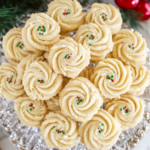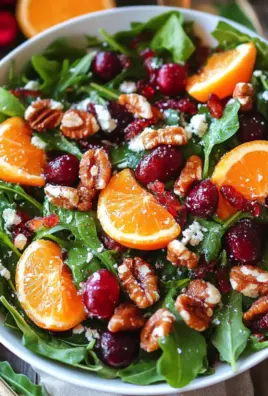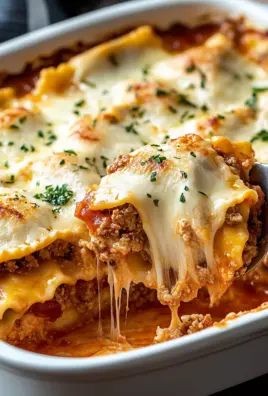Butter cookies are the quintessential holiday treat—crisp on the edges, soft in the center, and deeply rich with buttery flavor. This timeless cookie is simple in form yet elegant in taste, perfect for both everyday enjoyment and festive occasions. Often piped into beautiful shapes and sprinkled with colorful sugar, these cookies are as pleasing to the eye as they are to the palate.

Originating from European baking traditions, particularly Danish cuisine, butter cookies have made their way into kitchens across the globe. Their charm lies in their simplicity: just a few high-quality ingredients come together to create something extraordinary.
Why You’ll Love This Butter Cookie Recipe
This recipe stands out for its ease, elegance, and delightful results. Here’s why you’ll come back to it every season:
- Minimal ingredients: You likely already have everything you need in your pantry.
- Quick prep time: From start to oven in just a few minutes.
- Customizable shapes and finishes: Pipe into stars, circles, or rosettes, and top with sprinkles for a festive touch.
- Perfect texture: Soft and tender with a melt-in-your-mouth finish.
- Freezer-friendly: Great for making ahead or storing leftovers.
Whether you’re gifting them or enjoying them with a warm drink, these butter cookies deliver every time.
Preparation Phase: Setting Up for Success
Before you start baking, take a few moments to set up your kitchen and tools. Preparing properly can make the process smoother and your cookies better.
Essential Tools and Equipment
To ensure perfect results, you’ll need:
- Stand mixer or hand mixer – for creaming butter and sugar efficiently
- Large star piping tip – to achieve those classic piped cookie shapes
- Piping bags – for easy dough application
- Baking sheets – preferably light-colored for even baking
- Parchment paper – to prevent sticking and aid cleanup
- Measuring cups and spoons – for accurate ingredient portions
Why Each Tool Matters
Using a piping bag with a star tip gives butter cookies their iconic ridged appearance and festive charm. A stand mixer (or sturdy hand mixer) is essential for properly creaming the butter and sugar, which creates a light, airy dough. Parchment paper prevents sticking and helps the cookies bake evenly, without overbrowning on the bottom.
Ingredients
Use high-quality ingredients for the best texture and flavor. Here’s what you’ll need:
- 1 cup unsalted butter, softened (use premium brands like Kerrygold or Tillamook)
- 1 cup granulated sugar
- 1 large egg
- 2 teaspoons vanilla extract
- 2 cups all-purpose flour
- ½ teaspoon salt
- 1–2 tablespoons milk (any kind, as needed for consistency)
Ingredient Notes
- Butter: The heart of this recipe. Choose a rich, high-fat brand for optimal flavor.
- Sugar: Granulated sugar provides just enough sweetness without overpowering the butter.
- Egg: Adds structure and moisture.
- Vanilla: Enhances the overall aroma and flavor.
- Milk: Only add enough to make the dough pipeable; start with 1 tablespoon.
Step-by-Step Directions
Follow these steps closely to ensure your cookies turn out just right:
- Preheat oven to 350°F (175°C). Line baking sheets with parchment paper.
- In a large bowl or stand mixer, cream butter and sugar on medium-low until fluffy.
- Add the egg and vanilla. Mix until smooth and fully combined.
- Slowly add the flour and salt. Mix just until incorporated—do not overmix.
- Add milk, 1 tablespoon at a time, until dough reaches pipeable consistency.
- Transfer dough to a piping bag fitted with a large star tip. Pipe into circles or shapes on the baking sheet.
- Optionally, add sprinkles or sanding sugar for decoration.
- Chill the baking sheet for 20–30 minutes to help cookies retain their shape.
- Bake for 10–12 minutes, until edges are lightly golden.
- Let cookies cool completely on the baking sheet before serving or storing.
Bonus Tips
- Chilling is essential. It prevents the cookies from spreading and helps maintain definition.
- Piping consistency is key. If the dough is too stiff, add a bit more milk. Too soft? Add a tablespoon of flour.
- If cookies spread too much, try a different butter brand or use less milk.
How to Serve Butter Cookies
Butter cookies are incredibly versatile and can be served in many delightful ways. Whether you’re presenting them as part of a holiday spread or pairing them with an evening drink, these cookies adapt beautifully to every setting.
Serving Suggestions
- Holiday cookie trays: Arrange alongside sugar cookies and chocolate crinkles for a colorful assortment.
- Afternoon tea: Their delicate flavor and crisp edges make them perfect with a cup of Earl Grey or chamomile.
- Dessert platters: Pair with fruit, nuts, or chocolates for a more elevated dessert option.
- Gift boxes: Stack neatly in a festive tin or box lined with parchment for an elegant and tasty homemade gift.
- Dipped in chocolate: Dip one half of each cookie in melted dark or white chocolate and sprinkle with crushed nuts or sprinkles.
- Paired with ice cream: Serve with scoops of vanilla or butter pecan for a rich dessert pairing.
These options highlight how butter cookies can transition from everyday indulgence to celebration centerpiece.
Common Mistakes to Avoid When Making Butter Cookies
Achieving bakery-quality butter cookies at home is possible when you avoid these frequent pitfalls:
1. Overmixing the Dough
Once you add the flour, mix just until combined. Overmixing can lead to dense, tough cookies rather than tender ones.
2. Using Cold Butter
Cold butter won’t cream properly with sugar. Make sure your butter is softened to room temperature for the best texture and even mixing.
3. Skipping the Chill Time
Chilling is critical. It solidifies the fats in the dough, which helps maintain the piped shapes during baking and prevents excess spreading.
4. Adding Too Much Milk
Only use enough milk to reach a pipeable consistency. Too much liquid makes the dough too soft, resulting in flat, spread-out cookies.
5. Underbaking or Overbaking
These cookies are done when the edges are just starting to turn golden. Underbaking can make them doughy; overbaking makes them too crisp and dry.
6. Inconsistent Piping
Try to make your piped shapes uniform in size so they bake evenly. Inconsistent sizes can lead to uneven doneness.
Avoiding these issues will help you perfect your butter cookie technique, even on your first try.
Side Dish and Pairing Ideas
Though butter cookies are a treat on their own, pairing them with the right side items can turn them into a memorable dessert experience. Here are eight recommended pairings:
1. Hot Chocolate
A rich, creamy cup of hot cocoa complements the buttery flavor and soft texture of the cookies.
2. Chai Tea
The warm spices in chai balance the subtle sweetness of the cookies and create a comforting flavor profile.
3. Fresh Berries
Serve with strawberries or raspberries to add a fruity contrast and a burst of color to your dessert plate.
4. Whipped Cream Dip
A lightly sweetened whipped cream, flavored with a bit of vanilla or almond extract, makes a delightful dipping companion.
5. Espresso or Latte
For coffee lovers, the slight bitterness of espresso beautifully contrasts the rich, sweet notes of the cookies.
6. Vanilla Ice Cream
Create a dessert sandwich or serve on the side. The creamy texture of the ice cream pairs well with the cookies’ crisp edges.
7. Soft Cheese Platter
Try serving with a soft cheese like brie or mascarpone for a sophisticated take on sweet and savory.
8. Sparkling Cider
A bubbly, non-alcoholic cider offers a refreshing balance to the richness of the butter cookies, making it a kid-friendly and festive pairing.
These combinations can elevate your serving experience and bring out new dimensions in the cookies’ flavor and texture.
Use Premium Butter
The butter is the star of this recipe. Brands like Kerrygold, Tillamook, or Plugrá offer higher butterfat content and better flavor than standard options.
Try Flavor Variations
Add subtle but impactful twists:
- Almond extract: Use in place of vanilla for a nutty variation.
- Lemon or orange zest: Adds brightness and complexity.
- Cinnamon or cardamom: A dash of spice gives the cookies seasonal flair.
Dip and Decorate
After baking and cooling, dip cookies in melted chocolate and sprinkle with:
- Crushed peppermint
- Sea salt flakes
- Chopped pistachios
- Edible glitter or festive sugar
These additions enhance the texture and appearance without complicating the base recipe.
Use a Cookie Press for Uniform Shapes
If you want more consistency or traditional shapes, a cookie press can help. It produces beautiful, even designs and speeds up the shaping process.
Storage and Reheating Instructions
Butter cookies store well, making them perfect for prepping ahead of time or giving as edible gifts.
Room Temperature Storage
- Store in an airtight container for up to 7 days.
- Separate layers with parchment paper to avoid sticking or smudging designs.
Freezing Instructions
- Place baked and cooled cookies in a freezer-safe container or bag.
- Freeze for up to 6–8 months.
- To prevent freezer burn, wrap them in plastic wrap and place inside a zip-top bag.
You can also freeze unbaked piped dough on a tray, then transfer to a container for future baking. When ready, bake directly from frozen—just add 1 to 2 extra minutes.
Reheating Tips
While not necessary, you can gently warm cookies in a low oven (275°F) for 3 to 5 minutes to refresh them before serving. This restores a just-baked aroma and slight crispness.
Frequently Asked Questions
What is the difference between butter cookies and shortbread?
Butter cookies usually have a slightly higher sugar content and include an egg, which gives them a softer, more tender texture. Shortbread is denser and crumblier with a simpler flour-butter-sugar formula.
Can I freeze the dough?
Yes. Pipe the dough onto a baking sheet and freeze until solid. Transfer to a freezer-safe container and store for several months. Bake directly from frozen.
How do I prevent my cookies from spreading?
Ensure your butter is softened, not melted, and always chill piped dough before baking. If spreading persists, add a tablespoon more flour.
What butter works best?
Choose unsalted, high-fat European-style butter. Brands like Kerrygold or Plugrá deliver excellent richness and minimal water content.
Why do my butter cookies taste bland?
Check the quality of your butter and vanilla. Use real vanilla extract and a pinch of salt to balance sweetness and deepen flavor.
Can I use margarine instead of butter?
Technically, yes, but the flavor and texture will not match those made with real butter. For true butter cookies, butter is essential.
Can I add mix-ins?
Yes, but keep them small so they don’t affect the piping process. Try mini chocolate chips, finely chopped nuts, or citrus zest.
What piping tip should I use?
A large open star tip (such as Wilton 1M or Ateco 826) works best for classic designs and defined ridges.
Should I sift the flour?
Sifting isn’t required but can help produce a lighter, more uniform dough, especially if your flour is compacted.
Conclusion
This butter cookies recipe is a timeless classic with just the right balance of simplicity, elegance, and indulgence. With only a handful of pantry ingredients, you can create beautifully piped cookies that are perfect for holidays, gifting, or everyday treats.
Thanks to their rich flavor, crisp edges, and tender centers, butter cookies remain a favorite across generations. Use the tips and techniques in this guide to make them your own—from flavored variations to decorative finishes.
Try the recipe, experiment with your own additions, and don’t forget to share your creations. Happy baking.
Butter Cookies
Ingredients
- 1 cup unsalted butter softened (use high-quality brand such as Kerrygold, Challenge, or Tillamook)
- 1 cup granulated sugar
- 1 large egg
- 2 teaspoons vanilla extract
- 2 cups all-purpose flour
- ½ teaspoon salt
- 1 –2 tablespoons milk any kind, use as needed for piping consistency
Instructions
- Preheat oven to 350°F (175°C). Line a baking sheet with parchment paper and set aside.
- In a large mixing bowl or stand mixer, cream the softened butter and sugar together on medium-low speed until light and fluffy.
- Add the egg and vanilla extract and continue mixing until smooth and well combined.
- Gradually add the flour and salt, mixing just until fully incorporated. Do not overmix.
- Add milk 1 tablespoon at a time until the dough reaches a pipeable consistency. Use the least amount necessary.
- Transfer the dough to a piping bag fitted with a large star tip. Pipe small circles or shapes onto the prepared baking sheet. Add festive sprinkles if desired.
- Chill the baking sheet in the refrigerator for 20–30 minutes to help prevent spreading.
- Bake for 10–12 minutes, or until the edges just begin to turn golden brown.
- Let cookies cool completely on the baking sheet before serving or transferring.




Leave a Comment